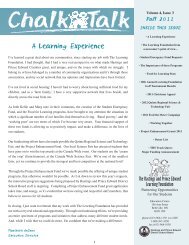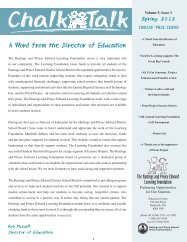Grade 11 Healthy Active Living Education Additional Supports ...
Grade 11 Healthy Active Living Education Additional Supports ...
Grade 11 Healthy Active Living Education Additional Supports ...
You also want an ePaper? Increase the reach of your titles
YUMPU automatically turns print PDFs into web optimized ePapers that Google loves.
Violence and Risk Taking Behaviour<br />
Public Profile<br />
Unit #3 Activity #6<br />
Teaching Learning Strategy #5<br />
Teacher Resource (Background Information)<br />
Catholic Profile<br />
Unit #2 Activity #4<br />
Teaching Learning Strategy N/A<br />
• Adolescence is a time for exploring, seeking out sensations and excitement. Some<br />
risks can be very exciting (e.g., riding on a roller coaster). Young people with<br />
characteristics related to risk-taking, sensation seeking and impulsiveness are more<br />
likely to be injured. (Robertson, 1992) Health Canada, www.hc-sc.gc.ca<br />
• It is important to remember that different people enjoy different kinds of risk-taking<br />
(e.g., some people like in-line skating and others do not, some people like public<br />
speaking and other people find this intimidating).<br />
Risk-taking behaviour changes due to:<br />
Life Experiences<br />
The ability to handle and take on risk changes because of the experiences gained<br />
and the skills developed over the years. Individuals develop the ability to assess<br />
risk and to assess the potential for harmful outcomes that may be associated with<br />
that risk.<br />
Choices to be made<br />
Individual choices can change the risk associated with situations and activities.<br />
These choices can modify the risk and prevent or minimize the potential for<br />
harmful outcomes (e.g., at a party drinking pop instead of beer, or drinking one<br />
beer slowly instead of having five or more).<br />
Other peopleÕs actions:<br />
Risk also changes because of the actions of other people around us (e.g., someone<br />
has agreed to be the designated driver for a group, but then has four or five<br />
drinks).<br />
Risks and Choices- Thinking Ahead and Thinking on your feet!<br />
When individuals think about the many different choices they have (before being<br />
in a situation as well as during that situation), it is easier to decide what to do and<br />
to be aware of what could happen.<br />
For example; before the party- Thinking ahead: ÒYou and some of your friends<br />
are going to a party where there will not be any adults. One of your friends is<br />
going to drive you all there, but you know that in the past this friend has got<br />
drunk. What back-up plan can you set up ahead of time so that you get home<br />
from the party safely?Ó<br />
During the party- Thinking on your feet: ÒThe friends you came to the party with<br />
are really out of it. What can you do to get yourself home safely? Are there<br />
things you can do for your friends?Ó<br />
Adapted with permission from Toronto Public Health, Risk Taking Teaching Package,<br />
1998<br />
<strong>Grade</strong> <strong>11</strong> <strong>Healthy</strong> <strong>Active</strong> <strong>Living</strong> <strong>Education</strong> (PPL30), Module #3 Violence and Risk Taking Behaviour<br />
Page 55
















